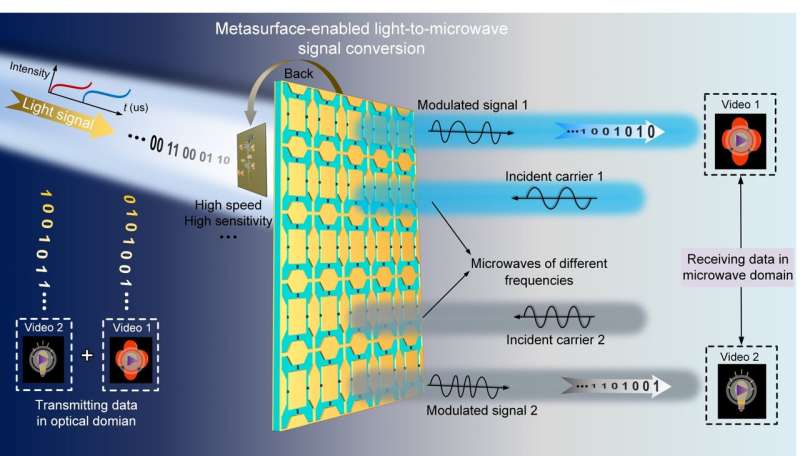A metasurface-based light-to-microwave transmitter for hybrid wireless communications

Today, wireless communications play an increasingly important role in our daily lives. For future "freewheeling" sixth generation (6G) wireless communications, the hybrid communication systems that can exploit advantages of both optical and microwave wireless technologies are critical. However, the traditional hybrid communication systems typically require a complicated relay to perform multiple operations, which will consume additional hardware/time/energy resources.
In a new paper published in Light Science & Application, a team of scientists, led by Professors Wei Xiang Jiang and Tie Jun Cui from State Key Laboratory of Millimeter Waves, School of Information Science and Engineering, Southeast University, China, and co-workers have developed a light-to-microwave transmitter based on the optically programmed time-varying metasurface for hybrid wireless communications. Such a metasurface transmitter is able to convert the light signal to the microwave domain directly, without using down-conversion process to baseband.
More interestingly, a single designed light signal can be converted to two microwave signals by using the dispersion characteristics of the metasurface. Based on the light-to-microwave transmitter, a dual-channel hybrid wireless communication system was realized, which can transmit two different videos simultaneously by using frequency division multiplexing (FDM) scheme. The reported method and technique will open new avenues for developing low-cost and low-complexity hybrid communication systems.
The hybrid transmitter is implemented by an optically programmed time-varying metasurface, which is constructed via the heterogeneous integration of a high-speed and linear photoelectric detection circuit into a reflective programmable metasurface. The profile of the whole platform is around 2 mm. With this hybrid integration strategy, the microwave reflection spectrum of the metasurface can be modulated by light intensity in high speed, thus achieving the direct light-to-microwave signal conversion and transmission. These scientists summarize the operational principle of their hybrid transmitter:
"We design an optically programmed time-varying metasurface for three purposes in one: (1) to perform real-time microwave manipulation by time-varying light signal; (2) to realize the direct light-to-microwave signal conversion based on spectrum control; (3) to implement the FDM using the dispersion response of the metasurface for achieving the dual-channel data transmissions in a light-to-microwave link."
"Using the transmitter, we further build a dual-channel hybrid wireless communication system, in which two different videos can be transferred from the optical transmitter to microwave receiver simultaneously and independently. The whole signal conversion process can be completed fully on a single platform, without any additional microwave devices and optical components," they added.
"The presented technique is able to implement the visible light communication and microwave communication simultaneously, which could be used for some typical applications where the two different communication links are required. Therefore, this breakthrough could open a new venue for future multi-domain integrated and full-spectrum 6G wireless communications," the scientists said.
More information: Xin Ge Zhang et al, A metasurface-based light-to-microwave transmitter for hybrid wireless communications, Light: Science & Applications (2022). DOI: 10.1038/s41377-022-00817-5
Journal information: Light: Science & Applications
Provided by Chinese Academy of Sciences





















